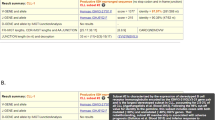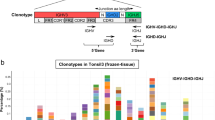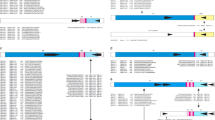Abstract
We used 3′-minor groove binder (MGB) technology to develop consensus fluorogenically labeled probes of the immunoglobulin heavy-chain (IgH) gene for detecting minimal residual disease (MRD) in B-cell non-Hodgkin lymphoma (B-NHL). Sequence data from 59 patients with B-NHLs revealed a narrow consensus region as a result of somatic hypermutations and variable VH usage, indicating that it would be difficult to design ordinary non-MGB probes. MGB probes, characterized by shorter length but higher melting temperature, are more suitable for this situation than ordinary non-MGB probes. In fact, the present data indicated that about 20% more cases were detectable with MGB probes (34/59, 57.6%) than with the non-MGB probes (23/59, 39.0%) designed by Donovan et al. MGB technology is useful for the design of consensus fluorogenically labeled probes of the IgH gene for detecting MRD.
Similar content being viewed by others
Main
Real-time quantitative polymerase chain reaction (RQ-PCR) is highly suitable for quantitative evaluation of minimal residual disease (MRD) in hematological malignancies.1, 2, 3, 4 In childhood acute lymphoblastic leukemia (ALL), strategies employing consensus germline probes and an allele-specific oligonucleotide (ASO) RQ-PCR method for targeting rearrangement of the immunoglobulin heavy-chain (IgH) gene have been established (Figure 1a) and used in multicenter studies to evaluate treatment efficacy.1, 2, 3, 4 Since the use of these consensus germline probes contributes to reducing costs and labor during large MRD studies, we were encouraged to establish a similar consensus strategy targeting the IgH gene to detect MRD in B-cell non-Hodgkin lymphoma (B-NHL).
Schematic diagrams of the probe/primer design used in the present study (a) and a comparison of consensus probe locations between ALL and B-NHL (b). (a), A consensus probe is designed for the VH gene segments with an ASO reverse primer designed complementary to the VH–DH or DH–JH junctional region and a patient-specific forward primer designed from the same strand for each germline. Each primer is indicated by an arrow and the probe by a bar. (b) In childhood ALL, consensus regions for probes are relatively wide because their sequences are all germline configuration. Consensus regions in B-NHL are narrow because of somatic hypermutations (indicated by vertical lines).
It has been difficult to design consensus probes for B-NHL because of the characteristic nature of the disease, involving somatic hypermutations and variable VH usage. In childhood ALL, defining consensus regions for probes is relatively easy since their sequences represent the germline configuration. Consensus regions in B-NHL are narrow as a result of the diversity arising from somatic hypermutations and variable VH usage (Figure 1b). In fact, we analyzed IgH sequences in 51 patients with B-NHL, and demonstrated the difficulty of designing conventional consensus fluorogenically labeled probes.5
Recently, DNA probes with conjugated 3′-minor groove binder (MGB) groups have been developed and used for 5′-nuclease PCR assays.6 These conjugates form extremely stable duplexes with single-stranded DNA targets, allowing the use of shorter probes for hybridization-based assays. The shorter length of the MGB probes results in better sequence specificity and lower fluorescent background staining compared with ordinary DNA probes (non-MGB probes) because of a reduction in nonspecific probe hybridization and the use of an internal nonfluorescent quencher instead of an ordinary 3′-quencher dye. In childhood ALL, we were able to design 10 MGB consensus probes corresponding to all IgH variable region (VH) germlines registered in the V BASE database (http://www.mrc-cpe.cam.ac.uk/DNAPLOT.php) and assess MRD even in cases that would normally require design of patient-specific probes (about 20% of total cases).7 In comparison with ordinary probes (21- to 27-mers), the MGB probes were shorter (16- to 18-mers) but had a high Tm (approximately 70°C). Therefore, MGB probes may be suitable for design of IgH consensus probes in B-NHL (Figure 1b).
In this study, we describe our attempt to design an RQ-PCR strategy using IgH MGB consensus probes in B-NHL, regardless of histological type, and demonstrate that about 20% more cases were detectable with our MGB probes than with the ordinary non-MGB probes designed by Donovan et al.1
Materials and methods
Samples and DNA Isolation
Our subjects comprised 59 patients including 51 who had been analyzed in our former study.5 As summary of the 51 patients and their sequence data are described in our previous report,5 and those of the eight additional patients are shown in Table 1. Permission for the study was obtained from the Institutional Review Board (IRB, Iwate Medical University School of Medicine, Morioka, Japan).
PCR-subcloning and Sequencing Analyses
PCR primers/conditions and sequencing methods for the VH gene analysis were described elsewhere.5 Briefly, DNA was isolated from formalin-fixed paraffin-embedded tissue sections using a QIAamp DNA tissue mini kit (Qiagen, Hildon, Germany). The isolated DNAs were amplified by two sets of seminested PCRs as described previously.5 The PCR products were analyzed by 2% agarose gel electrophoresis and stained with ethidium bromide. A clonal band of appropriate size was excised from the gel electrophoresis material and purified using a QIAquick Gel Extraction Kit (Qiagen). The product was ligated to pGEM-T Easy Vectors (Promega, Madison, WI, USA) and transformed into DH5α-competent cells (Toyobo, Tokyo, Japan). We selected 30 subcloned colonies at random from each patient and purified plasmid DNAs using a PI-200 DNA automatic isolation system (Kurabo, Osaka, Japan). Cycle sequencing was performed using a BigDye Terminator Cycle Sequencing FS Ready Reaction Kit (Applied Biosystems) and an ABI PRISM 3100 DNA sequencer (Applied Biosystems). The nucleotide sequences of each clone were aligned with the closest germline sequences derived from the V BASE database (http://www.mrc-cpe.cam.ac.uk/DNAPLOT.php).
Real-time Quantitative Polymerase Chain Reaction
The RQ-PCR assay was performed on an ABI PRISM 7700 Sequence Detector (Applied Biosystems). The reaction mixture contained 300 ng template DNA, 200 nmol/l each primer, 2 μM MGB probes and 25 μl TaqMan Universal PCR Master Mix (Applied Biosystems) in a final volume of 50 μl. The mixture was placed into 0.2-ml MicroAmp optical tubes with caps (Applied Biosystems). In the initial step, AmpErase uracil-N-glycosylase, which can be used to control carry-over contamination, was activated for 2 min at 50°C. This was followed by activation of AmpliTaq Gold DNA polymerase for 10 min at 95°C. The DNA was subjected to 50 cycles of a two-step PCR consisting of a 15-s denaturation step at 95°C and a 1-min combined annealing/extension step at 60°C.
Assay-specific standard curves for each set of primers and each probe were constructed by plotting the threshold cycle (Ct) against the known copy number of each positive control plasmid. The plasmid concentration was determined spectrophotometrically, and the copy number was calculated. The plasmids were diluted in a precise series, ranging from 5 pg to 0.005 fg (2 × 106) to two copies). For the normalization of each target, the copy number of β-actin was used as an internal control.5 In all RQ-PCR assays, peripheral mononuclear cells from 20 normal individuals were examined as negative controls.
Statistical Analysis
The incidence of somatic hypermutations was calculated from the number of hypermutations divided by the number of nucleotides examined, and expressed as a percentage. We compared the incidence of somatic hypermutations between the regions located on the consensus probes and the remaining sequences in framework region (FR) 3 using either Levene's nonparametric ANOVA by ranks followed by Dunnett's procedure or Wilcoxon's procedure.
Results
In all, 21 VH loci were identified in 59 patients with B-NHLs, the most frequent VH gene usage being VH3 (41/59, 69. 5%) (Table 2). The design of our RQ-PCR strategy is shown in Figure 1a. Our sequencing results suggested that consensus fluorogenic probes for both VH3 and VH4 should be based on the 5′ side of framework region 3 (FR3) because the frequency of somatic hypermutations was lower in this region than on the 3′-side (MGB-VH3A/MGB-VH3B/MGB-VH4; 1.86/1.92/2.53% vs remaining parts of FR3 regions of VH3 and VH4; 4.92%/7.85%) (Figure 2a). A significant difference (P<0.05) in the incidence of somatic hypermutations between these regions was confirmed.
Alignment of sequenced clones in three patients (VH3-33, VH3-23 and VH4-34) (a) and that of major clone sequences in patients with VH3 (b) and VH4 (c). Dashes indicate identity with the sequences in the upper position, and differences are indicated by capital (somatic mutations) and small (ongoing mutations) letters. The locations of the ordinary non-MGB probes (VH3A and VH4) designed by Donovan et al are circled with a dotted line. The locations of the MGB probes (MGB VH3A, MGB VH3C and MGB VH4) are circled.
Two consensus germline probes (non-MGB) for the VH3 region (VH3A and VH3B) have previously been developed for use in childhood ALL by Donovan et al.1 Their probes were located on the 5′ side of FR3, whereas it was not possible to use these directly for B-NHLs because of the characteristic VH usage specific to B-NHLs and of somatic hypermutations (Figure 2). Although we have designed three MGB probes with VH3 rearrangements for childhood ALL,7 only two of them (MGB VH3A and 3C) were applicable in this study (Figure 2b), because VH gene usage was restricted in the special subfamilies in B-NHL.5 Moreover, somatic hypermutations of VH4 occurred frequently in the non-MGB probe of the VH4 region designed by Donovan et al,1 and therefore this probe was applicable to only two of our 11 patients. We constructed a new probe, MGB VH4, based on the 5′ side of the FR3 region, whose sequence is common to all VH4 germlines and was applicable to eight of the 11 patients (72.7%) (Table 2 and Figure 2c). We also designed MGB consensus probes for VH1 and VH7 (Table 3), but their usefulness requires further investigation because of the small number of patients with these variants.7
The shorter length of our MGB probe was also useful for avoiding ongoing mutations (Figure 2a). Overall, we found that five of our MGB consensus germline probes completely matched VH sequences identified in the tumors of 34 (57.6%) of 59 patients, compared with 23 (39.0%) for conventional non-MGB probes (Table 2).
Discussion
In B-NHL, the IgH containing translocations such as BCL2/IgH and BCL1/IgH is often used as a target for RQ-PCR assays because standardization of the primer/probe sets, reagents and PCR conditions is relatively easy. However, these translocations can only be used in special histological types, and nearly half of all B-NHLs do not contain them. Owing to the variable nature of the IgH gene, it has previously been thought that developing an RQ-PCR assay for targeting IgH rearrangements in B-NHL would involve designing a new primer/probe set for every individual patient. Rearrangement of the diverse variable and joining segments of the IgH gene generate specific DNA sequences in each B-cell clone.8 In addition, somatic and ongoing mutations accelerate the diversity of the target region. Making a new primer/probe set correspond to the diverse IgH variable region (VH) gene sequences of each tumor would be too time-consuming and expensive in the clinical setting.
The present study demonstrates that quantitative assessment of MRD with a limited number of IgH MGB consensus probes would be feasible in patients with B-NHLs. In order to design the consensus probes, we had to overcome the physical restriction in probe length caused by VH usage specific to B-NHL and the locations of somatic hypermutations. These factors are associated with each other, and made the design of the consensus probes quite difficult.
MGB probes, characterized by a shorter length but a higher Tm, are more suitable for this situation than ordinary non-MGB probes. In fact, about 20% more cases were detectable with the MGB probes than with non-MGB probes. Moreover, excluding cases with FL, which frequently show BCL2/IgH gene rearrangement, 65.4% (34/52) of cases were detectable with this strategy. For the VH3 and VH4 families in particular, the most frequently encountered families in B-NHL,9 about 70% (32/46) of cases, were detectable with a limited number of MGB probes. The IgH ASO RQ-PCR assay with our MGB probes, together with several translocation markers, might make detection of MRD in B-NHL more feasible.
The MGB technology is significant in terms of its potential applicability to detection of other polymorphic or mutable genes. MGB conjugated with shorter primers might be appropriate for the PCR amplification of viral sequences that possess a high degree of variability.10 The use of shorter MGB probes may impact on the ability to carry out typing of highly polymorphic loci, such as MHC genes. Moreover, we have recently reported the high performance of MGB probes in discriminating the mutated allele of the K-ras gene and its clinical application for detecting occult tumor cells in colorectal cancers.11 In the future, MGB conjugated with primers/probes may contribute to a wide variety of diagnostic procedures.
References
Donovan JW, Ladetto M, Zou G, et al. Immunoglobulin heavy-chain consensus probes for real-time PCR quantification of residual disease in acute lymphoblastic leukemia. Blood 2000;95:2651–2658.
Verhagen OJ, Willemse MJ, Breunis WB, et al. Application of germline IGH probes in real-time quantitative PCR for the detection of minimal residual disease in acute lymphoblastic leukemia. Leukemia 2000;14:1426–1435.
Bruggemann M, Droese J, Bolz I, et al. Improved assessment of minimal residual disease in B cell malignancies using fluorogenic consensus probes for real-time quantitative PCR. Leukemia 2000;14:1419–1425.
van Dongen JJ, Seriu T, Panzer-Grumayer ER, et al. Prognostic value of minimal residual disease in acute lymphoblastic leukaemia in childhood. Lancet 1998;352:1731–1738.
Uchiyama M, Maesawa C, Yashima A, et al. Development of consensus fluorogenically labeled probes of the immunoglobulin heavy-chain gene for detecting minimal residual disease in B-cell non-Hodgkin lymphomas. Cancer Sci 2003;94:877–885.
Kutyavin IV, Afonina IA, Mills A, et al. 3′-Minor groove binder-DNA probes increase sequence specificity at PCR extension temperatures. Nucleic Acids Res 2000;28:655–661.
Uchiyama M, Maesawa C, Yashima A, et al. Development of immunoglobulin variable heavy-chain gene consensus probes with conjugated 3′-minor groove binder groups for monitoring minimal residual disease in childhood acute lymphoblastic leukemia. J Clin Pathol 2003;56:952–955.
Cook GP, Tomlinson IM . The human immunoglobulin VH repertoire. Immunol Today 1995;16:237–242.
Lossos IS, Okada CY, Tibshirani R, et al. Molecular analysis of immunoglobulin genes in diffuse large B-cell lymphomas. Blood 2000;95:1797–1803.
Afonina I, Zivarts M, Kutyavin I, et al. Efficient priming of PCR with short oligonucleotides conjugated to a minor groove binder. Nucleic Acids Res 1997;25:2657–2660.
Itabashi T, Maesawa C, Uchiyama M, et al. Quantitative detection of mutatnt alleles of the K-ras gene with minor groove binder-conjugated fluorogenic DNA probes. Int J Oncol 2004;24:687–696.
Acknowledgements
This work was supported by Grants-in-Aid 193671332, 13770705 and 13770093 from the Japanese Ministry of Education, Science, Sports and Culture of Japan.
Author information
Authors and Affiliations
Corresponding author
Rights and permissions
About this article
Cite this article
Uchiyama, M., Maesawa, C., Yashima-Abo, A. et al. Short consensus probes with 3′-minor groove binder of the immunoglobulin heavy-chain gene for real-time quantitative PCR in B-cell non-Hodgkin lymphomas. Lab Invest 84, 932–936 (2004). https://doi.org/10.1038/labinvest.3700092
Received:
Revised:
Accepted:
Published:
Issue Date:
DOI: https://doi.org/10.1038/labinvest.3700092





